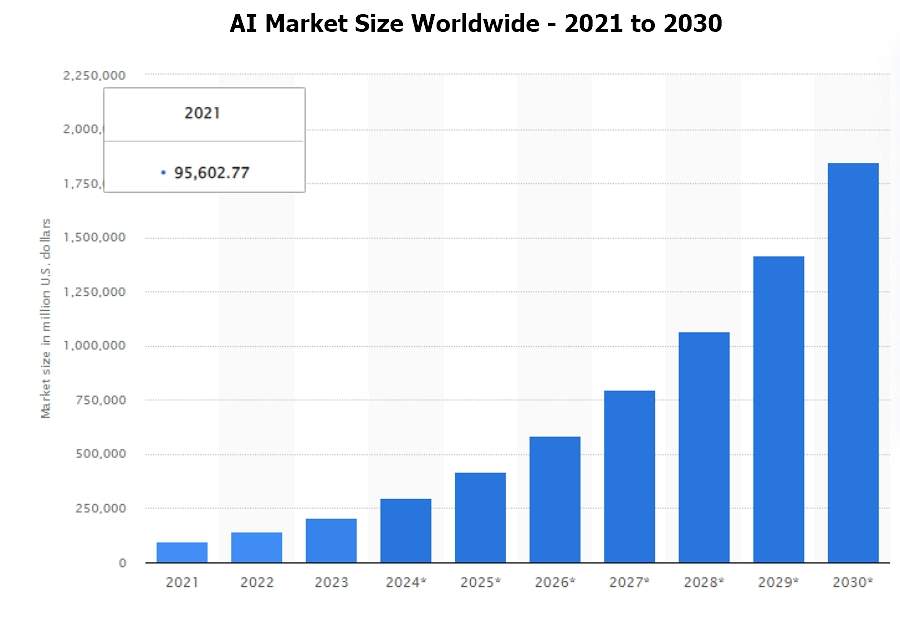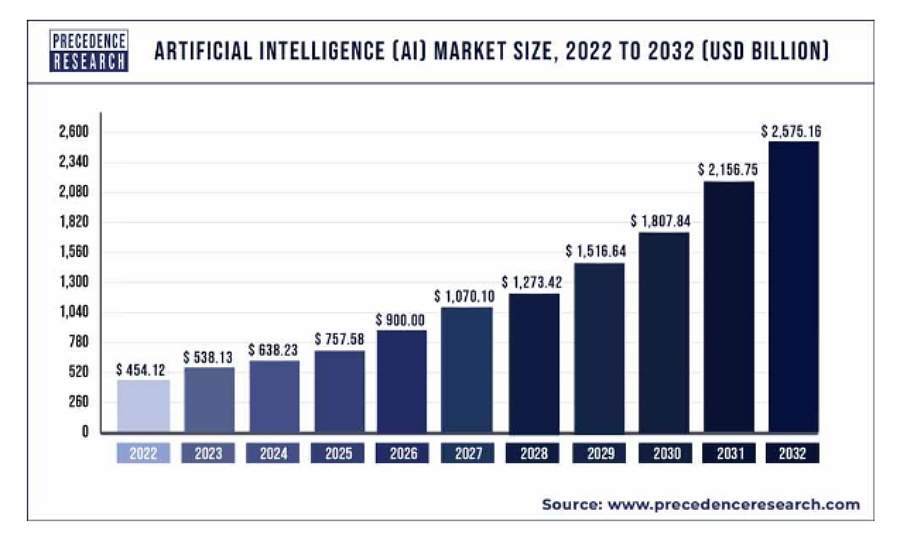In case you didn’t know, AI is a blazing economic, social, political, scientific and business wildfire raging just beyond control throughout the world. AI is being driven by the Four Horsemen of the 21st Century Apocalypse – The Run Amuck Colossus of the Dark Web, Deep Staters Vying to be Masters of Misinformation, Monopolists Seeking Irrefutable Do-Not-Go-To-Jail Cards, all its It is powered by the world hence a AI Trends summary for March 1 2024.
Along with the continuing Presidential Resurrection of Donald Trump, the self-immolation of both Hamas Gaza and Israel States, and Taylor Swift’s latest Fling with Love, Artificial Intelligence has also garnered a new Social Meme-ing. Thus, half-a-dozen AI-Artificial Intelligence macrotrends are can be surmised, leading to diverse conclusions for AI trends as of March 1 2024. One, consensus – Business Analysts see AI tools taking off just like internet technology 30 years before.
Starting in the 1950s to the 1990s internet development became a key system driver. Moore’s Law’s automatic hardware advances propelled new software linkages and interconnections to new levels of innovation. For example, in the 1950’s and 60’s, TCP and IP protocols allowed supercomputers to be time-shared and interconnected in large campus networks. In the 1970s, work on ARPANET utilizing cheap minicomputers and servers soon produced widespread 1000 node networks. So the introduction the Internet with free browsers and low cost HTML/JavaScript/CSS technology mixed with ever-cheaper transmission devices helped launch the WWW-World Wide Web WiFi outburst of innovations.
AI-Artificial Intelligence has seen a similar blossoming of interrelated technologies that are adding up to a fast-growing AI Wave:
Statista shows a $250 billion market in 2024 rising to $600 billion in 2026.
Precedence Research sees even larger AI market growth, from $638 billion in 2024 to $900 billion in 2026. Many consultants agree that Generative AI will race past currently popular media and story creation apps to be used in vital healthcare ops, business customer services, customer chat support, financial and insurance services. This Generative AI will drive the market for the next 2-3 years. Also, both groups see USA, European Union, and Asia Pacific experiencing the fastest AI growth. But a lot depends on the development and delivery of AI technology.
Here is the sequence of electronic and software technology advances that are propelling AI currently:
1 – Moore’s Law continues to deliver the same computing power for half the cost every two years. This trend is vital across the board for AI systems, as PCs, routers, AI servers, database engines, and transmission devices also show similar performance, cost, and reliability improvements. Quantum Computing may pick up the slack facing chip miniaturization due to hard physics limitations
2 – AI traditional or rule-based tools were first to deliver AI use in computationally complex tasks- An AI Task Specific program learned to beat the best chess, shogi, and go players in a complex rule derivation method. Rule-based AI has been used in prospecting systems or financial planning, where large steps/stages have to be foreseen and calculated out.
3 – Template based Web Design and Creation systems refined use of pre-built Web components with off the shelf widgets shaped by user specified options and responding to user or 3rd party sets of conditional usage triggers to structure the layout, style, and behavior of complex Web systems. This has became a key coding model for emerging AI systems.
4 – November 30 2022 OpenAI’s release of ChatGPT unleashed the AI Generative system race as the app enables users to refine and steer a conversation towards a desired answer in length, format, style, level of detail, and language. First, ChatGPT delivered text responses, then prompt generated images and media, now more broadly in targeted topic searches[legal, health, financial, historical, etc]. AI genned lists and story telling are the latest offerings. Successive prompts and replies, known as prompt engineering, are considered at each stage as a context for ChatGPT to refine its response.
ChatGPT spurred the development of competing products, including Google Gemini, Baidu Ernie Bot, Facebook LLaMA, Anthropic Claude, Tesla Grok and Microsoft Copilot, based on OpenAI’s GPT-4. But Generative AI has also immediately raised concerns about its sometimes gross generative errors, creation of media deepfakes, programs that displace or atrophy human intelligence, enable plagiarism, or fuel misinformation.
But the die was cast – as seen above, Systems Consultants see a major role for advanced Generative AI in Business Systems over the next 5 years as AI tools improve operations while satisfying customer needs. Here are some of the ways in which AI is expected to be creatively deployed.
2 – Edge AI will enable the processing of data at the point of creation on the edge, helping organizations to gain real-time insights, detect new patterns and meet stringent data privacy requirements This is part of the adoption of multi-modal AI.
3 – Responsible AI transforms AI into a positive force, rather than a threat to society and to itself. It outlines many aspects of making the right business and ethical choices such as business and societal value, risk, trust, transparency and accountability. It still has tenuous community commitment.
4 – Data-centric AI means a shift from being model- and code-centric to being more data focused to build better AI systems. AI-specific data management embraces synthetic data and data labeling technologies, aiming to solve many data challenges, including accessibility, volume, privacy, security, complexity and scope.
5 – Senior management AI commitment is reflected in a recent Gartner poll of more than 2,500 executive leaders found that 45% reported that ChatGPT buzz prompted them to increase AI investments. 75% said their organization is investigating generative AI, while 19% are in pilot or production mode.
TechTarget depicts the latest AI opportunity trends.
1 -AI multi-modal tools do 2 things. First, text prompts, verbal statements, image/video clips and sound signals are combined to help shape AI responses and deliver better outputs. Second, AI tools are nearing the ability to correlate and then respond to different input signals. This area is on the AI frontlines as seen below.
2 – Agentic AI marks a significant shift from rule-based reactive AI to a proactive multimodal approach. AI agents are imagined as many-input control signals that measure risk-state, goal opportunity, and changing relevant conditions. For an Agentic example, in environmental monitoring, an AI agent would collect data, analyze patterns and initiate preventive actions in response to varying hazards.
3 – Open Source AI looks to marshal the efforts of many players via some freely accessible AI software advances in exchange for not much as the AI majors[ChatGPT, Meta, Google, Microsoft, etc.] control the most powerful LLM models and dole out access to AI test environs. See recent Google 1, 2 , Meta 1, ChatGPT 4, IBM 3, for the state of AI accessibility from major AI vendors.
4 – RAG-Retrieval Augmented Generation uses a second input mode to diminish AI Hallucination errors where LLM models derive false conclusions. In AI Business models this is unacceptable results. RAG significantly improves results while reducing the size and cost of LLM models.
5. Customized enterprise generative AI models – uses RAG and shortcut methods to adapt major LLM models to niche-specific apps. The problem is that less-than-safe model methods increases chance of AI Hallucination errors or breaking fair-use rules.
6 – Scarcity of AI and machine learning talent is
Customized